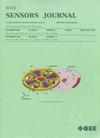基于碳量子点的无标记荧光生物传感器检测大肠杆菌
IF 4.3
2区 综合性期刊
Q1 ENGINEERING, ELECTRICAL & ELECTRONIC
引用次数: 0
摘要
我们以芹菜汁为碳源,通过水热法制备了碳量子点(CQDs)。银纳米粒子(Ag NPs)通过内滤光片效应(IFE)猝灭 CQDs 的荧光,利用 Ag NPs 作为吸收体构建无标记传感器。这种策略依赖于银纳米粒子的吸收光谱与荧光团的荧光激发或发射光谱重叠,以及$\textit {Escherichia coli (E. coli)}$ aptamers与目标物的特异性结合能力。当向系统中加入大肠杆菌时,游离的适配体序列首先被耗尽以形成复合物,从而导致Ag NPs在高浓度盐下聚集。此时,Ag NPs 的吸收光谱发生变化,不再与 CQDs 的荧光发射光谱重叠,从而导致系统的荧光显著恢复。制备的 CQDs 的激发波长为 348 nm,最大发射波长为 514 nm。平均粒径约为 8.84 nm,分散均匀。该传感器的线性范围为2/times 10^{mathbf {{2}}sim ~2/times 10^{mathbf {{7}}$ CFU $\cdot $ mL $^{\mathbf {-{1}}$ ,对大肠杆菌的检测限低至185 CFU $\cdot $ mL $^{\mathbf {-{1}}$ 。本文章由计算机程序翻译,如有差异,请以英文原文为准。
Carbon Quantum Dot-Based Label-Free Fluorescent Biosensor to Detect E. coli
We prepared carbon quantum dots (CQDs) by hydrothermal method using celery juice as carbon source. And the fluorescence of CQDs was burst by silver nanoparticles (Ag NPs) through inner filter effect (IFE), using Ag NPs as absorbers to construct label-free sensor. This strategy relies on the absorption spectra of Ag NPs overlapping with the fluorescence excitation or emission of fluorophores and the specific binding ability of
$\textit {Escherichia coli (E. coli)}$
aptamers with target. The free aptamer sequence is first depleted to form complexes, leading to Ag NPs aggregation at high salt concentrations when adding E. coli to system. At this point, the absorption spectrum of Ag NPs changes and no longer overlaps with the fluorescence emission spectrum of CQDs, leading to a significant fluorescence recovery of the system. The excitation wavelength of the prepared CQDs was 348 nm and the maximum emission wavelength was 514 nm. The average particle size was about 8.84 nm with uniform dispersion. The linear range of this sensor was
$2\times 10^{\mathbf {{2}}}\sim ~2\times 10^{\mathbf {{7}}}$
CFU
$\cdot $
mL
$^{\mathbf {-{1}}}$
, and the detection limit for E. coli was as low as 185 CFU
$\cdot $
mL
$^{\mathbf {-{1}}}$
.
求助全文
通过发布文献求助,成功后即可免费获取论文全文。
去求助
来源期刊

IEEE Sensors Journal
工程技术-工程:电子与电气
CiteScore
7.70
自引率
14.00%
发文量
2058
审稿时长
5.2 months
期刊介绍:
The fields of interest of the IEEE Sensors Journal are the theory, design , fabrication, manufacturing and applications of devices for sensing and transducing physical, chemical and biological phenomena, with emphasis on the electronics and physics aspect of sensors and integrated sensors-actuators. IEEE Sensors Journal deals with the following:
-Sensor Phenomenology, Modelling, and Evaluation
-Sensor Materials, Processing, and Fabrication
-Chemical and Gas Sensors
-Microfluidics and Biosensors
-Optical Sensors
-Physical Sensors: Temperature, Mechanical, Magnetic, and others
-Acoustic and Ultrasonic Sensors
-Sensor Packaging
-Sensor Networks
-Sensor Applications
-Sensor Systems: Signals, Processing, and Interfaces
-Actuators and Sensor Power Systems
-Sensor Signal Processing for high precision and stability (amplification, filtering, linearization, modulation/demodulation) and under harsh conditions (EMC, radiation, humidity, temperature); energy consumption/harvesting
-Sensor Data Processing (soft computing with sensor data, e.g., pattern recognition, machine learning, evolutionary computation; sensor data fusion, processing of wave e.g., electromagnetic and acoustic; and non-wave, e.g., chemical, gravity, particle, thermal, radiative and non-radiative sensor data, detection, estimation and classification based on sensor data)
-Sensors in Industrial Practice
 求助内容:
求助内容: 应助结果提醒方式:
应助结果提醒方式:


